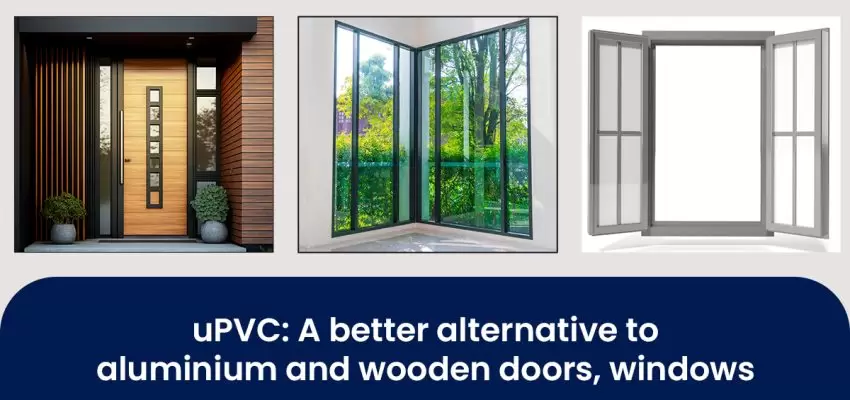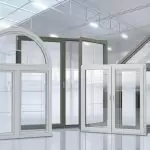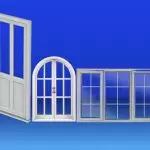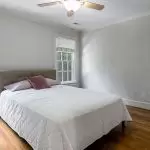When it comes to doors and windows, homeowners typically have three main material options – wood, aluminium and uPVC. While wooden and metallic frames ruled the roost traditionally, uPVC or Unplasticized PolyVinyl Chloride has emerged as a formidable contender in recent years. Let’s analyze how uPVC windows and doors compare to the conventional choices.
Post your Requirement
What is uPVC?
uPVC or unplasticized polyvinyl chloride is a versatile, lightweight synthetic polymer that has been gaining steady popularity for door and window frameworks.
Composition:
- Mainly pure rigid PVC resin without any plasticizers.
- Stabilizers to protect against heat and UV rays.
- Lubricants, fillers and impact modifiers.
Properties:
- Strong, stiff and sturdy.
- Resistant to heat, cold, chemicals.
- Exceptional weather-proofing abilities.
- Effective sound and heat insulation.
- Long service life spanning decades.
uPVC: Benefits Over Wood and Aluminium
uPVC frames have certain inherent advantages that make them superior to both wooden and aluminium options:
- Weather Resistance: With its non-corroding, nonconductive and watertight nature, uPVC provides all-weather durability retaining its smooth finish for decades. It does away with seasonal maintenance of painting, varnishing or polishing needed for wood and aluminium.
- Energy Efficiency: The low thermal conductivity of UPVC allows minimal heat transfer, cutting energy bills by preventing heat gain in summers and heat losses in winter. Special multi-chambered frame profiles with advanced glazing further bolsters insulation.
- Noise Reduction: The dense, airtight sealing of uPVC fittings coupled with double or triple glazing creates effective sound barriers cutting out external noise pollution – ideal for homes near airports or traffic zones.
- Customization Options: From bespoke shapes, colors and finishes to compatibility with electronic access control systems – uPVC profiles can be customized easily via extrusion molding in a range of configurations.
- Higher Safety: Inherent fire-retardant properties and advanced reinforcements make uPVC the safest choice. The polymerized structure leaves no scope for toxic emissions either.
- Eco-friendly Credentials: uPVC production utilizes waste salt byproducts. With enhanced recyclability and reuse potential, it reduces landfill piles up versus aluminium. Low maintenance needs also lower carbon footprint vis-a-vis wood.
- Cost Savings: Despite offering features at par with wood or aluminium, UPVC works out 30-50% cheaper due to ease of mechanical processing sans any costly specialized tooling or finishing needs. The costs are recovered within 5 years typically.
Why Some People Choose Wooden Profiles?
Advantages of uPVC Over Wooden Frameworks Wooden door and window frames do offer a classic, stylish appeal that uPVC cannot quite match aesthetically. However, the latter outweighs wooden profiles on multiple tangible parameters:
- All-Weather Durability: Exposed to moisture, humidity and pests, wooden frames undergo progressive damage necessitating periodic repairs, painting or varnishing. Sophisticated stabilizers impart exceptional weather-resistance to uPVC retaining its pristine looks for over 40 years sans any maintenance.
- Thermal Efficiency: With a thermal conductivity nearly 50 times lower than wood, uPVC allows substantial energy savings on space heating and cooling over time. Advanced seals block air leaks far more effectively as well. This directly reflects in reduced electricity bills.
- Enhanced Safety: Wood rots over time and is extremely combustible in case of a fire with the risk of spreading toxic fumes. With inbuilt fire retardance and sturdy screw retention even at high temperatures, uPVC offers higher safety assurance during offshore mishaps. Replacement needs are infrequent too due to robust screw retention.
- Lower Costs: Superior longevity coupled with negligible maintenance costs offset uPVC’s marginally higher upfront installation price over wood. Ease of mechanical processing skipped steps of seasonal painting, polishing or anti-termite treatments mandatory for wood – proving more pocket-friendly in the long run.
- Eco-friendly and Recyclable: Sourced from renewable forests, wood was once deemed eco-friendly. But modern furniture grade wood is harvested faster than replenishment rate. Chlorine from discarded PVC waste gets reused economizing on landfill waste. uPVC windows also have a recycled content of around 15%.
Advantages of uPVC Over Aluminium Frameworks
Advantages of uPVC Over Aluminium Frameworks are mentioned below :
- Enhanced Corrosion Resistance: Aluminium frames require repeated painting to avoid pitting, discoloration and decay especially in coastal areas with salt spray corrosion issues. uPVC withstands adverse effects of pollution, UV exposure and acid rain – retaining its surface finish for decades sans repainting.
- Lower Thermal Conductivity: With thermal conductivity 100 to 250 times lower than aluminium, uPVC prevents condensation accumulation and temperature fluctuations inside homes or offices much more effectively year-round. This allows cutting back on heating/cooling expenses.
- Noise Abatement: The non-resonant constitution and thicker, multi-chambered insulating profiles lend remarkable noise dampening capacity to uPVC over light-weight aluminium frames – creating greater tranquility indoors.
- Improved Safety Against Break-In Attempts: Reinforced with galvanized steel or aluminium for rigidity, uPVC profiles are tougher to forcibly pry open by burglars versus aluminium frames. Elaborate hardware mechanisms provide additional security.
- Cost Factor: Fabrication and installation expense of aluminium windows get amplified by surface pre-treatment needs before primer/paint application. uPVC skips these steps along with frequent repainting jobs slashing long-term ownership costs.
Conclusion
With its signature strengths of weather-resistance, energy efficiency, noise insulation and security built right into the material constitution rather than via additional coatings or layers – uPVC frames deliver performance comparable or even superior to conventional wood and aluminium at relatively lower procurement and ownership expenses. Eco-friendly credentials with enhanced recyclability and reuse coupled with easier fabrication that promotes shorter installation times further bolster the value proposition for homeowners as well as architects! Clearly, UPVC systems are better poised to serve as the mainstream choice for doors and windows in current context rather than just low-budget alternatives. Continued material advances and polymer modifications can further consolidate their position as the ideal replacement for traditional materials on key technical parameters.
FAQs
Q-1. What is the composition of uPVC?
A-1. uPVC, or Unplasticized PolyVinyl Chloride, is mainly composed of pure rigid PVC resin, stabilizers for heat and UV protection, and lubricants.
Q-2. How does uPVC compare to wood in terms of durability?
A-2. Unlike wood, uPVC offers all-weather durability, resisting moisture and pests without the need for periodic repairs or maintenance.
Q-3. What advantages does uPVC have over aluminum in terms of thermal efficiency?
A-3. uPVC’s low thermal conductivity, 100 to 250 times lower than aluminum, leads to substantial energy savings and better insulation against temperature fluctuations.
Q-4. Why is uPVC considered more cost-effective compared to traditional materials?
A-4. Despite comparable features, uPVC is 30-50% cheaper due to easy mechanical processing, lower maintenance, and quicker cost recovery within 5 years.























Post A Comment